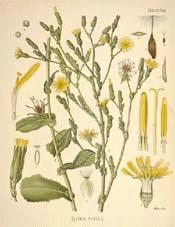
Botanical.com Home Page

|
Bitter Lettuce
(Lactuca virosa LINN.)
Click on graphic for larger image
|
Lettuce, Wild
Botanical: Lactuca virosa (LINN.)
Family: N.O. Compositae
---Synonyms---Lactucarium. Strong-scented Lettuce. Green Endive. Lettuce Opium. Laitue vireuse. Acrid Lettuce.
---Parts Used---The dried milk-juice (Lactuarium), the leaves.
---Habitat---Western and Southern Europe, including Britain.
---Description---The name lactuca is derived from the classical Latin name for the milky juice, virosa, or 'poisonous.'
It is a biennial herb growing to a maximum height of 6 feet. The erect stem, springing from a brown tap-root, is smooth and pale green, sometimes spotted with purple. There are a few prickles on the lower part and short horizontal branches above. The numerous, large, radical leaves are from 6 to 18 inches long, entire, and obovate-oblong. The stem leaves are scanty, alternate, and small, clasping the stem with two small lobes. The heads are numerous and shortly-stalked, the pale-yellow corolla being strap-shaped. The rough, black fruit is oval, with a broad wing along the edge, and prolonged above into a long, white beak carrying silvery tufts of hair. The whole plant is rich in a milky juice that flows freely from any wound. This has a bitter taste and a narcotic odour. When dry, it hardens, turns brown, and is known as lactucarium.
---Habitat---The Wild Lettuce grows on banks and waste places, flowering in July and August. It is cultivated in Austria, France, Germany and Scotland. Collectors cut the heads of the plants and scrape the juice into china vessels several times daily until it is exhausted. By slightly warming and tapping, it is turned out of its cup mould, is cut into quarters and dried.
In the United States, after importation from Germany via England it is said to be used as an adulterant for opium. It is usually found in irregular, reddish-brown lumps the size of a large pea, frequently mouldy on the outside. In the United States the German and French lactucarium is considered inferior to the British product.
All lettuces possess some of this narcotie juice, Lactuca virosa having the most, and the others in the following order: L. scariola, or Prickly Lettuce, L. altissima, L. Canadensis, or Wild Lettuce of America, and L. sativa, or Garden Lettuce. Cultivation has lessened the narcotic properties of the last, but it is still used for making a lotion for the skin useful in sunburn and roughness. The Ancients held the lettuce in high esteem for its cooling and refreshing properties. The Emperor Augustus attributed his recovery from a dangerous illness to it; built an altar to it, and erected a statue in its honour.
Lactucarium is not easily powdered, and is only slightly soluble in boiling water, though it softens and becomes plastic.
Thridace, or the inspissated juice of L. capitata, is now regarded as inert.
A mild oil, used in cooking, is said to be obtained from the seeds in Egypt.
[Top]
---Constituents---L. virosa has been found to contain lactucic acid, lactucopicrin, 50 to 60 per cent lactucerin (lactucone) and lactucin. Lactucarium treated with boiling water and filtered is clear, but on cooling the filtrate becomes turbid. It is not coloured blue by iodine test solution. The usual constituents of latex are albumen, mannite, and caoutchouc.
The fresh juice reddens litmus paper.
---Medicinal Action and Uses---The drug resembles a feeble opium without its tendency to upset the digestive system. It is used to a small extent as a sedative and narcotic.
Dissolved in wine it is said to be a good anodyne.
Dr. Collins stated that twenty-three out of twenty-four cases of dropsy were cured by taking doses of 18 grains to 3 drachms of extract in twenty-four hours. It is used in Germany in this complaint, but combined with more active drugs. It is said to be also a mild diaphoretic and diuretic, easing colic, inducing sleep and allaying cough.
Water distilled from lettuce (eau de laitre) is used in France as a mild sedative in doses of 2 to 4 OZ., and the fresh leaves boiled in water are sometimes used as a cataplasm.
Moderate doses given to the lower animals act as a narcotic poison, an injection having even caused death.
---Dosages---Of powder, 10 to 20 grains or more. Of tincture, 30 to 60 drops. Of alcoholic extract, 1 to 5 grains. Of Lactucarium, 5 to 20 grains. Of fluid extract leaves, 1/4 to 1 drachm. Of syrup, U.S.P., 2 drachms. Tincture, U.S.P., 30 drops.
Common Name Index
A MODERN HERBAL Home Page
Bear in mind "A Modern Herbal" was written with the conventional wisdom of the early 1900's. This should be taken into account as some of the information may now be considered inaccurate, or not in accordance with modern medicine.
© Copyright Protected 1995-2024 Botanical.com
|

